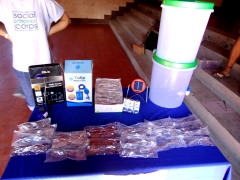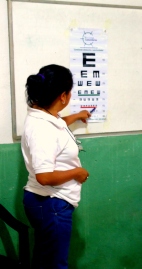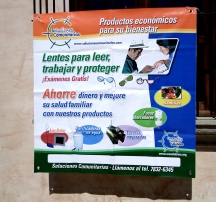Maria Pacheco has a Dream:

Maria Pacheco
“That all communities have houses…that all houses have a window…that from all windows a garden may be seen…that in all gardens there is a ball…that all balls belong to girls and boys that go to school…that all the schools have PTA’s with parents that work…that all who work, may reach the markets…that markets multiply houses with windows…that in the new windows birds and trees are multiplied…so the sky may be blue and the sun bright for everyone!”[1]
Maria has been working for the better part of her life to turn this dream into a reality. Her aim is to provide these communities with a source of income, enabling them to invest in their own futures. Maria spent years working with various communities, trying out a variety of ways to help them produce income. In 2003, she combined the lessons she learned from her many projects, partnered with the talented Queta Rodriguez and Ligia Chinchilla, and founded Kiej de los Bosques, a social enterprise with the goal of connecting rural artisans to the global market, thereby creating a sustainable source of income.

Wakami Jewelry [2]
In order to create lasting impact within the communities, Kiej partners with the NGO,
Communities of the Earth. The NGO serves as a business incubator, providing the training necessary to turn a group of rural women into a legalized business. The incubation process takes 2 years and costs a total of $25,000. Communities are selected based on a vision and desire to make money and change their own lives.The training begins with dream workshop where the women share their dreams and visit successful business women. Kiej then sends in a fashion design team to teach the women how to make
Wakami branded products which Kiej sells in national and international markets. Over the course of the 2-year incubation period the companies are aided by local technicians and provided with periodic business training courses.
As soon as a community begins to make and save money, they begin the Wakami Village Methodology, a 3 part combination of goods and services to transform their lives.[3]
- Wakami Family: 5 important indicators are monitored: income generated, taxes paid, weight and height of children, school attendance, banking and savings accounts.
- Wakami Home: sustainable products that can significantly improve health, the economy, and the environment are presented to the communities at affordable prices. These products include: Ecofiltro water filters, Onil stoves, rain water collecting systems, Quetsol solar lighting systems, and organic garden kits.
- Wakami Community: programs are created to encourage community participation. These include: solid waste management programs, recreational parks programs, participation in local decision making spaces, girls clubs, school improvements, and medical and dental missions.
Kiej currently works with 17 rural companies (16 in Guatemala and 1 in Panama), 12 of which are comprised of mothers and 5 of young people working to pay for their education. The Wakami products are exported to more than 14 countries around the world.
This rural development project seems great on paper but it wasn’t until visiting one of the villages and hearing the leaders of the rural companies speak about how their lives have been changed that I was able to truly appreciate the incredible level of sustainable development that Maria and her team have instigated. What stood out most, as the business leaders spoke, was the new-found sense of empowerment and pride they had in themselves, their skills, and the life-changing products they were able to provide for their families.

Francisca
Francisca, the leader of the San Rafael based company, dreams to own her own land someday. Although she cannot read or write, she has a very keen business sense and was elected to lead the Wakami company in her village. She had never worked before because she had to stay home to care for her family. At first, she told us, she thought the idea of starting a business was much to difficult. She was also wary of the idea because she had seen so many development projects come and go. However, she took the risk, and as soon as she earned her first paycheck she began to believe in the project. She is able to work from her home and is currently learning to read and write. She also takes a bus into Guatemala City once a week to deliver the finished products, pick up new supplies, and learn how to make new designs which she then teaches to the rest of the women in her company. She told us, with tears in her eyes, that her company’s paycheck last month (for 4 women) was 7,700Q, almost $1,000.

Maria
Maria, the leader of the Ixil based company, admitted that in the beginning she didn’t believe in the business. The women in her community were accustomed to staying at home all day and no one wanted to do extra work. However, she said that as soon as they began to make a little bit of money they became encouraged. Now they all want to work so much that they stay up all night when a big order comes in. Before they started their company, none of the women had ever been to the bank and had no idea how to deposit checks. Now, Maria proudly proclaimed, dealing with money is easy for them and most have their own savings accounts, separate from their husbands. Last months paycheck for the Ixil company (for 16 women) was 49,000Q, almost $6,300.

Alejandra
Alejandra, the leader of the Candelaria based company, said that in the beginning her husband was not happy about her work. During the first four months of training, he was angry that she spent so much time working but had nothing to show from it. The husbands in her village expected their meals at a certain time and the chores to be done a certain way. They were not used to their wives being busy and it took a while for them to become more flexible. As soon as Alejandra began to make money, her husband started to appreciate his wives job. In the community of Candelaria, the income earned from the company was especially important because the husbands worked on a coffee plantation and had little or no source of income for the majority of the year. Alejandra said she felt empowered that she was able to play such an important role in providing the main source of income for her family during the non-coffee season. With the money, she has been able to purchase a water filter, a solar energy system, and a stove. She no longer has to burn wood to purify water or to cook, purging the 1-room, dirt floor home that her 6 person family shares of harmful smoke. Now she also has a source of light so her children can study in the evenings and she can work to produce jewelry.
The visit with these incredible women ended with a circle of light in which everyone linked arms, lit candles, and listened to the inspirational words of Maria Pacheco,
“An individual dream is very powerful but you can’t stop a collective dream from coming to life.”

___________
[1] http://www.kiejdelosbosques.com/kiejDeLosBosques_dream.html
[2] https://www.facebook.com/photo.php?fbid=10151165456283868&set=o.10406620986&type=3&theater
[3] http://www.comunidadesdelatierra.org/metodologiaDeTrabajo_en.html


 no cost. Once the product is sold, the entrepreneur pays back the organization, pockets a portion of the profit, and restocks in order to sell more. This model is ideal for those living at the bottom of the pyramid since it requires no monetary investment, allows for flexibility in schedule, has minimal barriers to entry, and provides entrepreneurial training and experience that act as a stepping stone to future entrepreneurial activities.
no cost. Once the product is sold, the entrepreneur pays back the organization, pockets a portion of the profit, and restocks in order to sell more. This model is ideal for those living at the bottom of the pyramid since it requires no monetary investment, allows for flexibility in schedule, has minimal barriers to entry, and provides entrepreneurial training and experience that act as a stepping stone to future entrepreneurial activities. The MCM has spread relatively quickly throughout the developing world and has found great success in India, Africa (particularly South Africa), and parts of Latin America. The MCM was developed less than a decade ago in the rural village of Nebaj, Guatemala by a Peace Corps volunteer named Greg Van Kirk. The idea of MicroConsignment was born when Greg donated the profits from the tourism business he created (as part of his peace corps assignment) to a wood-burning stove project. He quickly realized that his donations were not sustainable and began to locally manufacture the stoves instead. He found local entrepreneurs to market and sell the stoves (on consignment) to low income families in nearby villages. The stoves were interest-free and micro-payment options were made available. Greg created a model in which high-quality, health-enhancing products were brought to rural villagers at affordable prices by local individuals who were trained to be entrepreneurs and provided with income-generating opportunities.
The MCM has spread relatively quickly throughout the developing world and has found great success in India, Africa (particularly South Africa), and parts of Latin America. The MCM was developed less than a decade ago in the rural village of Nebaj, Guatemala by a Peace Corps volunteer named Greg Van Kirk. The idea of MicroConsignment was born when Greg donated the profits from the tourism business he created (as part of his peace corps assignment) to a wood-burning stove project. He quickly realized that his donations were not sustainable and began to locally manufacture the stoves instead. He found local entrepreneurs to market and sell the stoves (on consignment) to low income families in nearby villages. The stoves were interest-free and micro-payment options were made available. Greg created a model in which high-quality, health-enhancing products were brought to rural villagers at affordable prices by local individuals who were trained to be entrepreneurs and provided with income-generating opportunities. Everyone has their own opinion on how to best eliminate poverty. Greg Van Kirk found an innovate way to both empower and employ locals and to bring affordable products to those in need.
Everyone has their own opinion on how to best eliminate poverty. Greg Van Kirk found an innovate way to both empower and employ locals and to bring affordable products to those in need.













